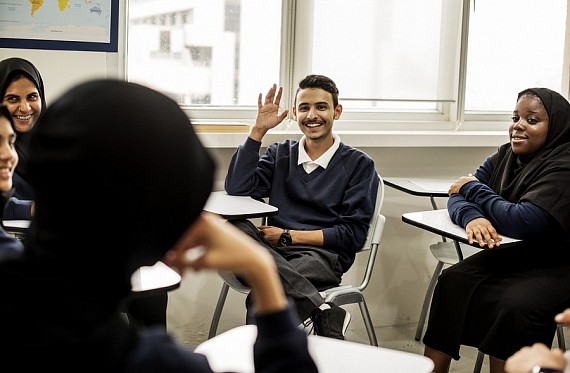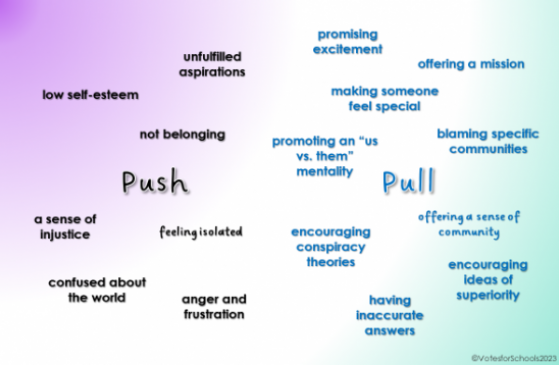Approaching British Values and Prevent in the Classroom
Empowering Teachers and Students to spot the signs of extremism & radicalisation
Part of our Teacher Toolkit Series on teaching British Values in Schools
Part of our Teacher Toolkit Series on teaching British Values in Schools
First published July 2023, by admin
Since 2020, there has been a sharp rise in right-wing extremism, particularly online. This has led to radicalisation and in some cases, terrorist plots being developed by young people in the UK.
Schools and other educational settings have a legal duty to do everything in their power to prevent people from being drawn into extremism and terrorism. The legal framework comes under Section 26 of the Counter Terrorism and Security Act 2015, as stated in Keeping Children Safe in Education 2020 and is an Ofsted requirement, known as the Prevent Duty. Every adult in your school should be confident in being able to recognise the signs and indicators that children and young people may be being radicalised or are beginning to develop extremist views. Of course, these concerns should be discussed with the Designated Safeguarding Lead or equivalent.
It's one thing to recognise signs and be fastidious with following up on concerns. However, it is also a duty to give young people the opportunity to discuss extremism, radicalisation, and terrorism. It is important to remember that discussing these areas is as important as reporting concerns about young people.
So, how do you do that? What’s the most effective way to approach these topics without fear of causing harm or misrepresenting information? How can you make it age-appropriate? How do you avoid unhelpful stereotypes that could make some feel even more alienated? The curriculum is already overloaded, where is the time to cover these massive areas?
These are all valid concerns. But they must be overcome. Schools and colleges at their most ideal are safe environments that allow these discussions to happen. After all, discussing these topics is a legal duty, just as learning about sexual exploitation or FGM is.
As a former teacher of Religion and Philosophy, I have seen first-hand that enquiry-based learning can bear the most fruit in the classroom. In other words, teacher-led discussions can give pupils the confidence to reflect on difficult subjects such as religion, war, and other important areas. I have compiled some useful tips to help teachers feel supported and confident in discussing extremism, radicalisation, and terrorism including what to look out for and how to ensure your pupils are safe and supported. There is also a free lesson pack which will help you discuss extremism in your classroom that you can download below.
Our lessons on extremism explore: whether we respect views that are different to ours (Primary 5-7), whether or not we can recognise extreme views (Primary 7-11) and whether or not extreme right-wing views are pursuasive to young people (Secondary and Colleges). All of this, as well as assemblies on British Values for both Primary and Secondary schools are available to download below.
Please note: these resources were created in July 2023 so do not include mention of current affairs since that date
DownloadPlease provide the following information to access the free downloads.

You may have heard this phrase a lot, without much explanation of what it really means. A safe space doesn’t have to be anything fancy; it could be as simple as a classroom, some non-judgemental conversations, and opportunities to freely express thoughts and feelings. It’s important to remember that the phrase “safe space” might not resonate with all young people. You could call it “ideas hour” or “airing out your feelings”, adapt the name based on your students' needs and just let your imagination run wild! The idea is to give young people the confidence to lead a conversation or discussion. They must feel empowered before examining and questioning their ideas. Without feeling empowered, it may not be possible to confront difficult feelings or dangerous ideas. Of course, having a safe space is important, but having solid relationships with your students will drive the conversations.
With my Year 9 class, we started a Book Club called “The Open Door of Perception “ - students played board games, answered a philosophical question on the board, and eventually were able to discuss and confront difficult feelings or possible ambiguities in their life. It doesn’t have to be as elaborate as this (nor do you need philosophical conundrums!), but a place students can meet and air out ideas, feelings and concerns is valuable, if not essential. It will just take a little time and patience, as well as some clear and robust boundaries.

With curriculum time becoming limited it is easy to fall into the trap of only finding the time to talk about topics such as extremism and confronting serious issues during assembly and tutor time. However, prevent should be integrated throughout the curriculum. We know that may sound difficult, but here are some handy tips:
Identify relevant opportunities within existing subjects.
Take a cross-curricular approach by collaborating with colleagues.
Use timely events as catalysts for discussions.
Invite guest speakers and experts to share their insights.
Utilise available resources, including websites and educational platforms.
Stay updated on government initiatives and programs for guidance and training.
By being flexible and creative, you can address these issues while ensuring a comprehensive and engaging curriculum for your students. And don't forget, VotesforSchools are here for just that. We ensure full coverage of the prevent guidance in your school as well as many other curriculum areas. You can see for yourselves with our 4-week free trial...
Sign up now
These are key when planning and delivering lessons on extremism to young people. Democracy; rule of law; individual liberty; and mutual respect and tolerance of those of different faiths and beliefs: these are key when planning and delivering lessons on extremism to young people. It’s useful to get students to think about how these ideas extend beyond a set of resources, or a specific lesson. For example, setting up a School Council shows democracy in action and acknowledging a rang of religious or cultural festivals on a regular basis allows pupils to go further than tolerating different faiths and beliefs. With younger ages groups, you could even discuss school rules and why they are in place.
Ultimately, extremist views are a direct challenge to these fundamental values. So if you allow your students to discuss them more frequently, they will feel more confident in challenging those who do not subscribe to them. So, have a display in your classroom, spend some time getting pupils to think about British Values, and encourage children to challenge those who do not promote these values.

Politics and social issues are accessible to all abilities, it's all about finding an "in". Make a point of allowing students the time to think closely about what is happening in the world. Combined with a safe space, they should be encouraged to challenge, debate and make reasoned arguments. There are so many great ways you can facilitate these conversations; for example, with my year 10 class, every Monday tutor time would turn into “debate time". From Artificial Intelligence to the Brexit Referendum, students were able to consider and challenge their own and each other's views.
It’s also important to remember that challenging or disagreeing with someone is healthy, not something to shy away from. Make sure there is a classroom culture in which young people appreciate that these challenges sharpen and extend their thinking. Indeed, dangerous and extreme views happen in a vacuum, so the more ideas and the greater diversity of opinion a young person receives, the easier it will be for them to be critical of the views they see and the ways in which such ideas could pose a risk to them or their peers.
Trial VotesforSchools
It’s critical that you are aware and conscious of those who may be more vulnerable to radicalisation. There are sadly groups of children who are more likely to be radicalised into extremism or terrorism. The government report "Understanding and identifying radicalisation risk in your education setting," states that, "Identifying susceptibility to extremist ideologies or radicalisation is not a straightforward process, as it can vary greatly from person to person." It highlights that individuals vulnerable to grooming for sexual exploitation, criminal exploitation, or involvement in county lines may also be susceptible to radicalisation. The report emphasises the importance of recognising factors such as adverse childhood experiences, influences from family, peers, and online connections, which can heighten someone's vulnerability to radicalisation. It recommends that educators remain vigilant, promote open dialogue, and establish a supportive and inclusive learning environment. And lastly, remember that prevent ‘is not about getting people vulnerable to radicalisation into trouble, it’s about supporting them.’

Unfortunately, there is no clear way of recognising whether a young person is at risk of taking on extremist ideologies or becoming vulnerable to radicalisation. It goes without saying that each case is unique and there are no clear boxes to be ticked in order to prevent situations such as these from happening. The government has, however, compiled a list of factors that, when seen together can raise a cause for concern. These factors, often referred to as push and pull factors, can allow educators to have a clearer understanding of the risks involved with extremism and radicalisation. We go into further detail about each push and pull factor below, providing examples to help you visualise what this could look like.
Push factors
Push factors are exactly as they sound, they are the personal situations or aspects within society that push young people forcefully towards extremist groups and ideologiesThe Government’s identified push factors are: .
isolated
they do not belong
they have no purpose
low self-esteem
their aspirations are unmet
anger or frustration
a sense of injustice
confused about life or the world
real or perceived personal grievances
Pull factors
On the opposite side, pull factors are the things that could ‘pull’ young people towards extremist ideologies, making them seem more attractive by promising belonging, purpose or significance. The Government's identified pull factors are:

What to look out for? No case is the same and every person's experience is unique, how can you all remain vigilant? The report "Understanding and identifying radicalisation risk in your education setting" emphasises the importance of recognising mixed, unclear, or unstable cases in which children, young people, and adult learners may display engagement with or adoption of ideologies that support extreme violence.
These cases present unique challenges in identifying and addressing radicalisation. The government highlights key characteristics and behaviours associated with such cases, which should provide valuable insights for you and your colleagues to be alert.
Here are the key points from 'Educate Against Hate' regarding signs of potential extremism in students:
Outward appearance:
Changing friends and appearance
Distancing themselves from old friends
No longer enjoying activities they used to engage in
Converting to a new religion
Being secretive and reluctant to discuss their whereabouts
Online behaviour:
Changing online identity
Having multiple online identities
Spending excessive time online or on the phone
Accessing extremist online content
Joining or attempting to join extremist organisations
Behavioural changes:
Becoming increasingly argumentative
Refusing to listen to different points of view
Unwilling to engage with students who are different
Becoming abusive to students who are different
Embracing conspiracy theories
Feeling persecuted
Being sympathetic to extremist ideologies and groups
Advice for educators:
Trust your professional judgement
Seek advice if something feels wrong
Stay vigilant and aware of your students' behaviour
By being aware of these signs as well as potential vulnerabilities and taking appropriate action, educators can play a crucial role in identifying and addressing potential extremism among students.

As teachers, we're well versed in listening to what our pupils say and being on the lookout for any safeguarding concerns. Just like in other areas, we need to remain aware of the signs that could demonstrate extremism - even down to the smallest things such as a passing comment about a concerning video that they've seen online, or a change in behaviour that cannot be explained. With perpetrators testing out new methods of radicalisation all of the time, it's a good idea to keep a note of the things that you notice (using your school's chosen safeguarding system) as these details can act as puzzle pieces to create the fuller picture and allow for an early intervention. As previously mentioned, any overt signs must be reported immediately to your Designated Safeguarding lead so that the appropriate response can be set up.
Schools and childcare providers should have clear procedures in place to protect children at risk of radicalisation, which can be included in existing safeguarding policies. Separate policies for implementing the Prevent duty are not necessary. General safeguarding principles apply, as outlined in statutory guidance. School staff and childcare providers should know when to refer individuals to the voluntary Channel program, which provides early-stage support for those vulnerable to terrorism. Detailed guidance and an online training module are available to aid understanding of identifying vulnerabilities to radicalisation and appropriate interventions.
Approaching these difficult topics armed with these tips can help you feel confident if you are tasked with planning and delivering a lesson on extremism. And remember, we do have some free resources that can help you get started.
Abdul has worked in education for over five years. His experiences range from teaching at a pupil referral unit to teaching Greek philosophy. Abdul is passionate about the spiritual and ethical education of students.